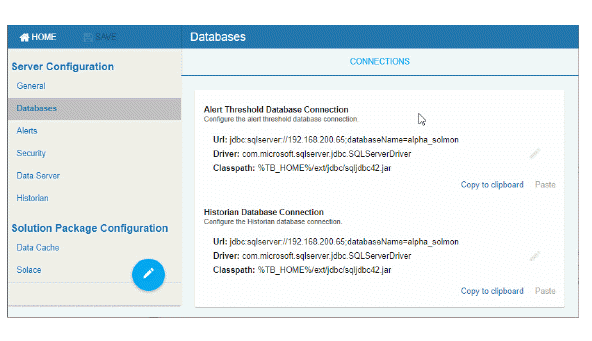
Use the Databases page to setup the Alert Threshold Database Connection and the Historian Database Connection.
Click Copy to clipboard on any RTView Servers database field to copy it to the clipboard. Then click Paste on any of the other connection listed.
The settings you make here are applied to all Monitor servers. For example, when you change the historian database connection in this tab, the database connection for the Alert Historian also changes, as well as for the Solution Package for Solace servers.

The Databases page has the following fields:
|
Field Name |
Description |
|
Alert Threshold Database Connection |
This is the connection to use for the Alert Threshold database. This database contains all alert settings (warning and alarm thresholds, etc). |
|
|
URL: Full URL to use when connecting to this database using the specified JDBC driver. |
|
|
Driver: Fully qualified name of the driver class to use when connection to this database via JDBC. |
|
|
Classpath: The classpath to the jar containing the driver class. |
|
|
Username: (optional) User name to enter into this database when making a connection. |
|
|
Password: (optional) Password to enter into this database when making a connection. Click Create new password to change your password. |
|
|
Run Queries Concurrently: If true, each query on the connection is run on its own execution thread. Note: This option should be used with caution since it may cause SQL errors when used with some database configurations and may degrade performance due to additional database server overhead. See your database documentation to see whether it supports concurrent queries on multiple threads. |
|
Historian Database Connection |
This is the connection to use for the Historian database. |
|
|
URL: Full URL to use when connecting to this database using the specified JDBC driver. |
|
|
Driver: Fully qualified name of the driver class to use when connection to this database via JDBC. |
|
|
Classpath: The classpath to the jar containing the driver class. |
|
|
Username: (optional) User name to enter into this database when making a connection. |
|
|
Password: (optional) Password to enter into this database when making a connection. |
|
|
Run Queries Concurrently: If true, each query on the connection is run on its own execution thread. Note: This option should be used with caution since it may cause SQL errors when used with some database configurations and may degrade performance due to additional database server overhead. See your database documentation to see whether it supports concurrent queries on multiple threads. |